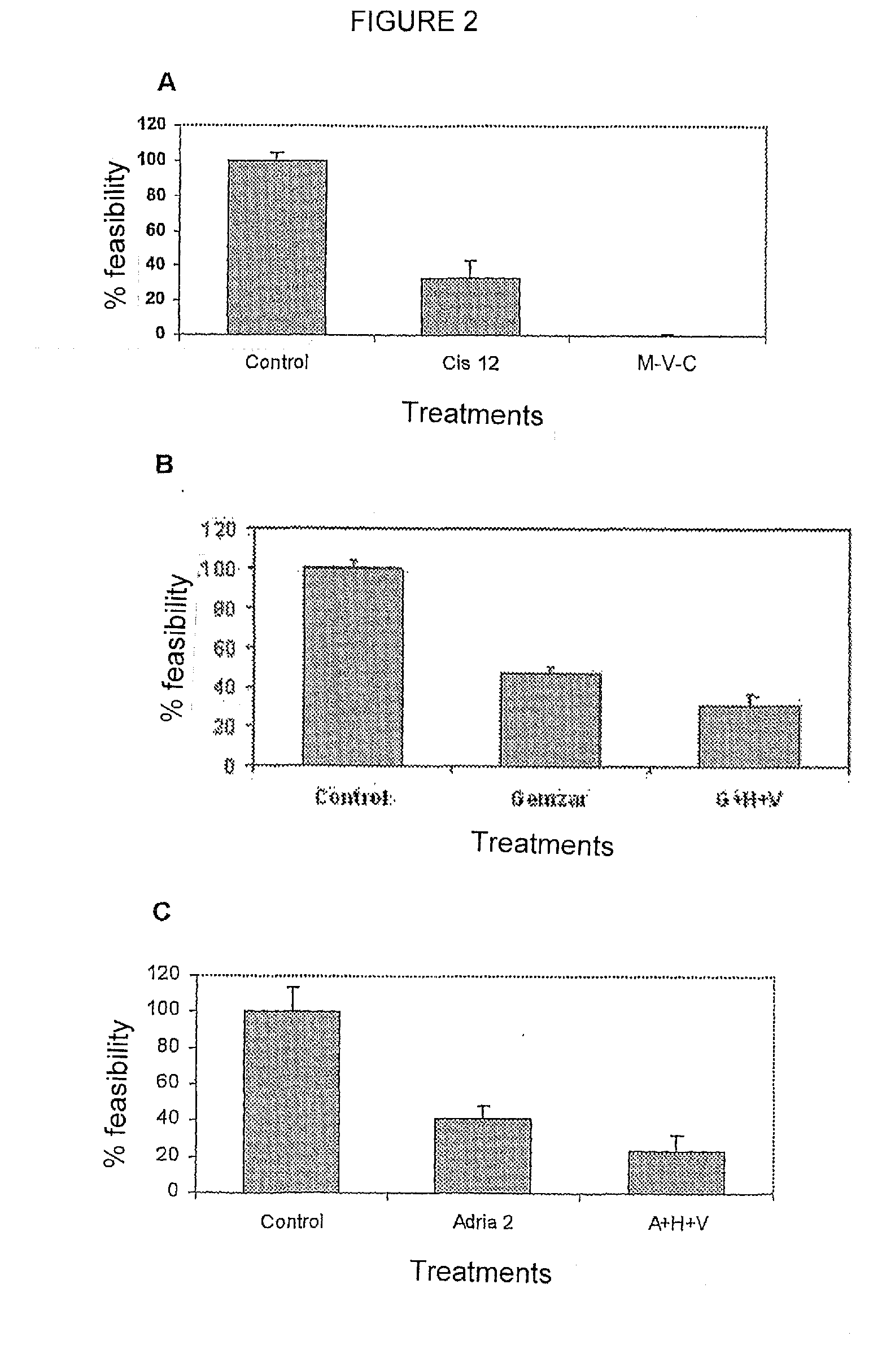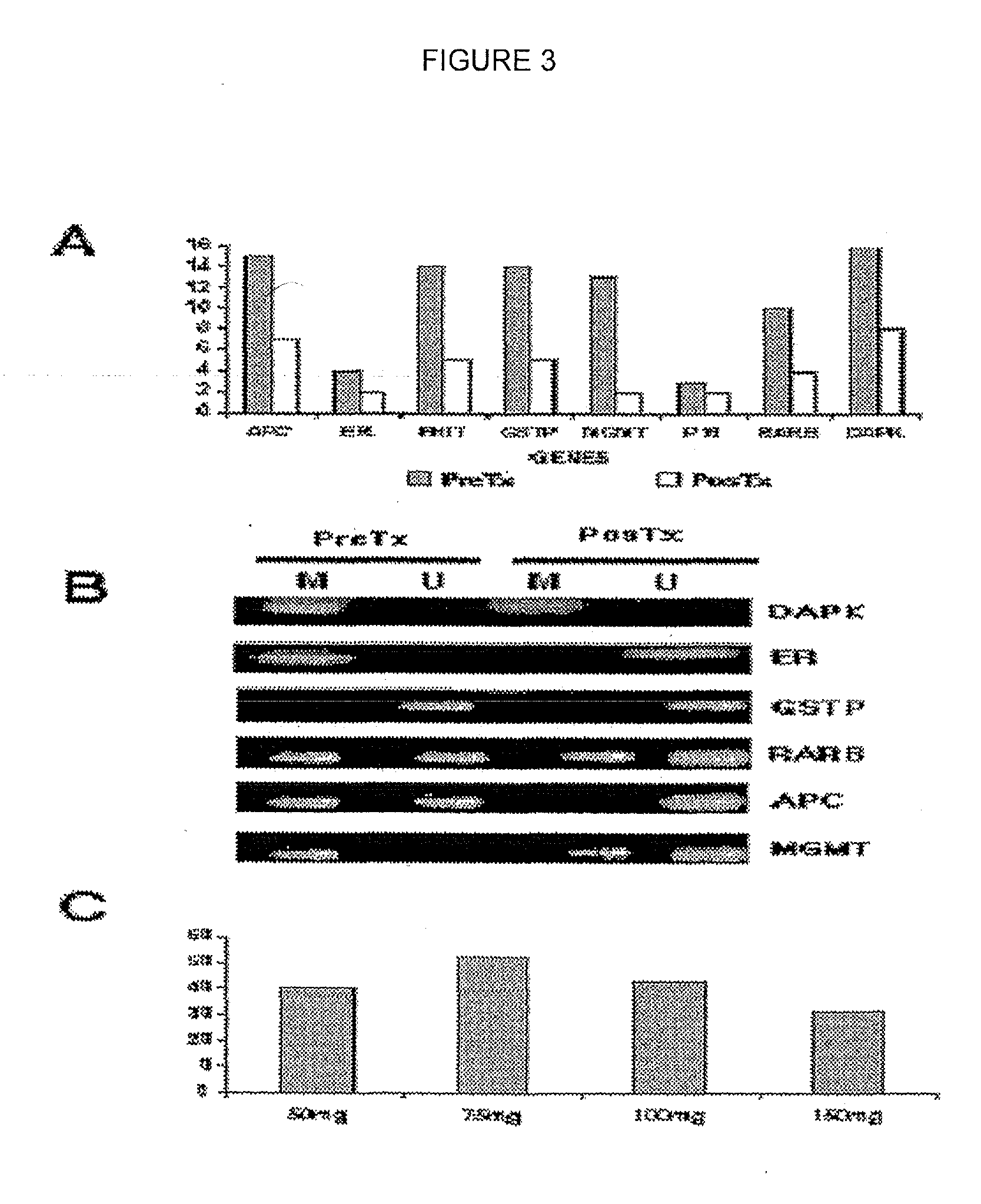Use of Transcriptome Modifying Agents and Chemotherapy or Radiotherapy Against Cancer
a transcriptome modifying agent and transcriptome technology, applied in the field of use, can solve the problems of human cancer treatment still challenging, picture is much more complicated, and the treatment of human cancer is still far from optimal
- Summary
- Abstract
- Description
- Claims
- Application Information
AI Technical Summary
Problems solved by technology
Method used
Image
Examples
example of use 1
[0028]To demonstrate that the transcriptome modifying composition, hydralazine and valproic acid or magnesium valproate has antitumoral effects, a variety of cellular malignant lines from cervicouterine cancer, breast, colon, upper respiratory and digestive tract cancer, and sarcoma were used. The cells were plated in 96-well plates (Falcon Becton Dickinson, Franklin Lakes, N.J.) at a density of 1.5-2.5×103 cells / well in 0.1 ml of complete media. The following day the cells were treated with hydralazine at 10 μM and magnesium valproate at 1 mM for 4 days. The following day, cellular viability was measured using a MTT assay. Briefly, 50 μl of MTT reagent in phosphate buffered solution were added to each well. Viable cells with active mitochondria reduce MTT to a precipitable purple compound—formazan—which dissolves with DMSO adding 150 μl to each well. Thereafter it is read spectrophotometrically on a ELISA reader. All the assays were carried out in triplicate. The cytotoxic effect o...
example of use 2
[0030]Once demonstrated that the transcriptome modifying composition had inhibitory effects on the growth of the cellular malignant lines, it was investigated whether the composition increased the cytotoxic effect chemotherapeutic agents. With this objective, three drugs were selected that are representative of his class: alkylating agents as cisplatin, antibiotic as doxorrubicin, antimetabolite as gemcitabine. The cells were plated in 96-well plates (Falcon Becton Dickinson, Franklin Lakes, N.J.) at a density of 1.5-2.5×103 cells / well in 0.1 ml of complete media. The following day the cells were treated with the chemotherapeutic agent at the concentration indicated in FIGS. 2A, 2B y 2C plus hydralazine at 10 μM and valproic acid or magnesium valproate at 1 mM. On the next day, the media containing the drugs was removed and fresh hydralazine and magnesium valproate were added at same concentration for another additional 48 hours. On the following day (day 4) cell viability was measu...
example of use 3
[0031]To demonstrate that the demethylating and reactivating effect from the transcription of suppresive genes can be achieved clinically, a phase I clinical study was carried out to demonstrate at which dose hydralazine can have its demethylating and reactivating effect of transcription in cancer patients. Whit this goal, hydralazine was administered to groups of 4 patients each group at doses of: 1) 50 mg / day, 2) 75 mg / day, 3) 100 mg / day and 4) 150 mg / day for 10 days. Biopsies and peripheral blood samples were taken before commencing treatment and at day 11. The state of pre- and post-treatment methylation was analyzed for the promoters of the following genes: APC, MGMT; ER, GSTP1, DAPK, RARβ, FHIT and p16 as well as the state of expression of their messengers by RT-PCR. Also the state of methylation of the gene subject to parental unactivation H19, and a genomic clone which normally is found methylated was evaluated, as well as the global content of methylated citokines in the ge...
PUM
| Property | Measurement | Unit |
|---|---|---|
| weight | aaaaa | aaaaa |
| weight | aaaaa | aaaaa |
| weight | aaaaa | aaaaa |
Abstract
Description
Claims
Application Information
 Login to View More
Login to View More - R&D
- Intellectual Property
- Life Sciences
- Materials
- Tech Scout
- Unparalleled Data Quality
- Higher Quality Content
- 60% Fewer Hallucinations
Browse by: Latest US Patents, China's latest patents, Technical Efficacy Thesaurus, Application Domain, Technology Topic, Popular Technical Reports.
© 2025 PatSnap. All rights reserved.Legal|Privacy policy|Modern Slavery Act Transparency Statement|Sitemap|About US| Contact US: help@patsnap.com



